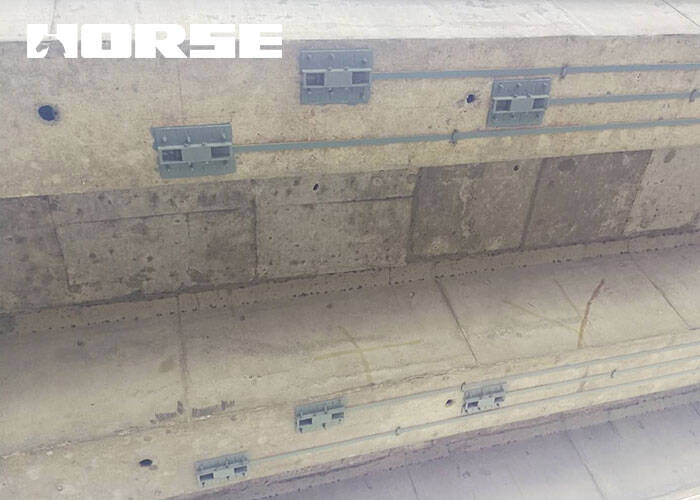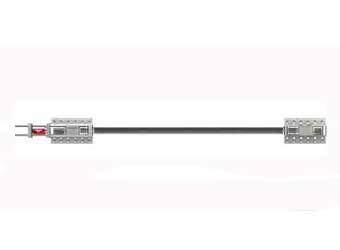Solutions
Horse Construction offers full range of structural strengthening materials with technical supports, documentation supports, products supports, project supports.
As an active reinforcement technology, the inverse bending moment generated by the pre-load offsets the internal force generated by the partial load, which can improve its performance and greatly increase its bearing capacity. It should be given priority in the selection of reinforcement methods.

1.1 Development and application of prestress technology
Before the engineering structural members bear external loads, pre-compression stresses are applied to the tensile members to increase the stiffness of the members, delay the occurrence of cracks, and increase the durability of the members. For the mechanical structure, stress is generated in advance to increase the rigidity of the structure itself and reduce vibration and elastic deformation. Doing so can significantly improve the elastic strength of the tension member and make the original bearing capacity stronger. This technology is called prestress technology. Prestressing technology includes component force calculation, prestressing materials, anchoring system, and prestressing construction.
According to different construction techniques, prestressing technology is divided into pre-tensioning method and post-tensioning method. As an important branch of post-tensioning prestressing technology, the external prestressing tendons are simple in layout and easy to adjust, simplifying the operating procedures of post-tensioning, and greatly shortening the construction time. At the same time, because the prestressed tendons are arranged outside the web, it is convenient to cast concrete. Due to the location of the prestressed tendons, friction damage during the construction process is reduced and the replacement of the prestressed tendons is convenient and easy. Especially in structural reinforcement such as bridge structural defect repair and improvement of bearing capacity, external prestressing technology is widely used.
1.2 Development of prestressed materials
With the continuous advancement of prestressing technology, prestressing materials have also continued to develop. The research and application of prestressed materials are divided into the following cold drawn steel bars, cold drawn steel wires, medium-strength prestressed steel bars, high-strength low-relaxation prestressed steel wires, steel strands, and non-metallic prestressed materials. According to the production and construction process, it can be divided into bonded and unbonded prestressed materials. With the development of prestressing technology and the accumulation of practical experience, prestressing materials have also been continuously improved in construction tensioning and anchoring, anti-corrosion and protection techniques, and a variety of prestressing construction methods and patented technologies have been formed. The production and construction of materials have also formed corresponding national standards and industry standards, making prestressing technology more mature and meeting many types of structural requirements.
2.1 External prestress reinforcement technology
External prestress reinforcement technology is an active stress reinforcement technology. It applies additional stress to reduce the internal force of the original structure, improve the stress state of the original structure, and increase the bearing capacity of the original structure. External prestressed reinforcement is generally based on the test and identification results of structures. Reinforcement includes: reinforcement to improve the normal performance of the structure, that is, reinforcement to reduce structural deformation or reduce structural cracks; reinforcement to improve structural bearing capacity; seismic reinforcement, etc.
2.2 External prestressed reinforcement materials
Because the external prestress is located outside the structure and is easily affected by the external environment, its anti-corrosion requirements are relatively high. At this stage, external prestressing materials are generally high-strength and low-relaxation unbonded prestressed steel strands, epoxy sprayed prestressed steel strands, epoxy sprayed unbonded prestressed steel strands, carbon fiber sheets, etc. The anchor system is generally zinc-plated copper alloy or chrome-plated anchor with a protective cover. At the same time, the protection of external prestressed structures is particularly important
2.3 Mechanical properties of external prestressed reinforcement
The external prestressed tendons are located on the outside of the structure and may be connected to the structure only in the anchoring area and the turning block. Therefore, the stress of the external prestressed tendons is determined by the overall deformation of the structure. Naturally it becomes a separate component relative to the integral structure.
The areas where the external prestress is mainly subjected to concentrated stress are the steering block and the anchoring area.
After the external prestress is applied to the structure, the main focus of the prestress is at the anchoring area and the position of the steering block. Under the action of dynamic load, the external prestressing tendons and the original structure vibrate independently, and the two tend to resonate. Fatigue failure of anchors and bending fatigue failure of pre-stressed tendons at steering members are prone to occur, especially during seismic reinforcement.
For the original prestressed structure, after the structure is externally prestressed, the stress of the original prestressed structure will be relatively released, and the internal force of the structure will be redistributed.
2.4 Features of external prestressed reinforcement
Because external prestress is located outside the structure, it has unique advantages during construction, and has been widely used in bridge reinforcement.
It can be inspected, maintained and replaced within the service life of the structure;
Simple construction process, less interference with traffic, simple equipment required, less manpower input, short construction period, and obvious economic benefits; small damage to the original structure, without affecting the clearance under the bridge;
The beam shape is simple, the friction loss is small, and the quality control during construction is convenient;
It can greatly improve or restore the bearing capacity and crack resistance of the bridge, and the reinforcement effect is obvious.
External prestressing technology is used for bridge repair and reinforcement. It has the characteristics of simple construction, short construction period, low investment, and obvious effect. It can be implemented without interrupting traffic and has little damage to the structure.
As an active reinforcement technology, the inverse bending moment generated by the pre-load offsets the internal force generated by the partial load, which can improve its performance and greatly increase its bearing capacity. It should be given priority in the selection of reinforcement methods.
You can find anything here you are in need of, have a trust trying on these products, you will find the big difference after that.

High strength, unidirectional carbon fiber wrap pre-saturated to form a carbon fiber reinforced polymer (CFRP) wrap used to strengthen structural concrete elements.

High strength carbon fiber reinforced polymer (CFRP) strip / laminate / plate for structural strengthening and concrete repair

Prestressed carbon fiber reinforced polymer(CFRP) plate for slab, beam strengthening to increase stiffness, reduce distortion and deflection of members, reduce the cracks, avoid and stop cracking.